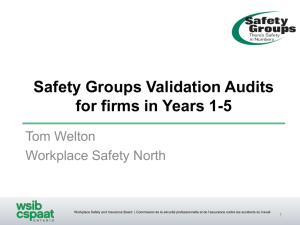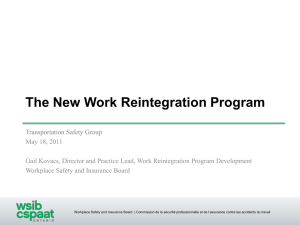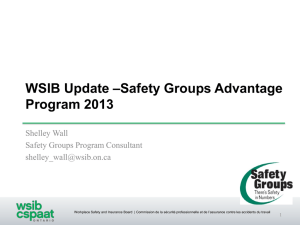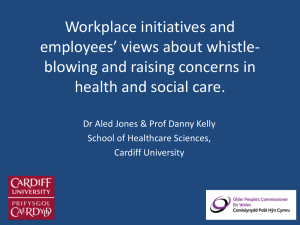Presentation Title - Career Colleges Ontario
advertisement
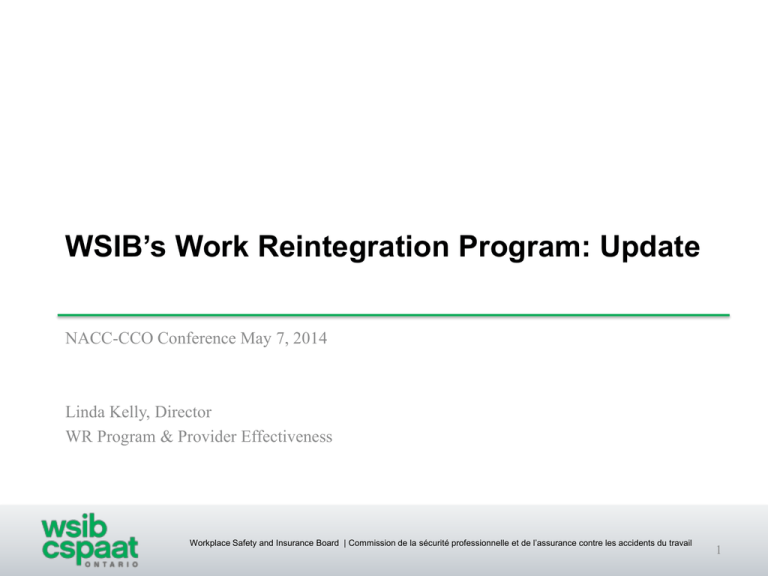
WSIB’s Work Reintegration Program: Update NACC-CCO Conference May 7, 2014 Linda Kelly, Director WR Program & Provider Effectiveness Workplace Safety and Insurance Board | Commission de la sécurité professionnelle et de l’assurance contre les accidents du travail 1 Background ■ WSIB implemented its Work Reintegration (WR) Program in 2010 ■ Emphasis placed on RTW with the injury employer and practical retraining programs; included training for RTW with injury employer ■ Two in-house roles to assist workplace parties: RTW Specialist and (new) Work Transition Specialist ■ New WR Policies outlined services with time and cost limits for training ■ Services more worker-centric i.e. more input and choice, more pathways available ■ Improved provider oversight Workplace Safety and Insurance Board | Commission de la sécurité professionnelle et de l’assurance contre les accidents du travail 2 Results So Far ■ Employed Outcomes: – 92% of workers RTW at full wages within one year – 50% of cases referred to Work Transition Specialist resulted in RTW with injury employer, and – 70% RTW overall including with new employer ■ Satisfaction rates (overall) with Work Transition Services: – Worker – 84% – Employer – 86% ■ More workers returning to work faster ■ Fewer workers require training for new jobs Workplace Safety and Insurance Board | Commission de la sécurité professionnelle et de l’assurance contre les accidents du travail 3 Impact on Training Providers ■ Workers requiring ESL, Academic Upgrading and Literacy/Essential Skills training: more choose private colleges 700 Number and Percentage of Active ESL, Literacy and Academic Upgrading Training Programs 100% 90% 600 80% 500 70% 60% 400 50% 300 40% 30% 200 20% 100 10% 0 Jan-13 Feb-13 Mar-13 Apr-13 May-13 Jun-13 Jul-13 Aug-13 Sep-13 Oct-13 Nov-13 Dec-13 Private - Number Active in Training 449 448 390 397 373 360 378 320 327 328 319 317 Public - Number Active in Training 123 129 134 147 134 139 141 55 58 63 80 72 Public - Percentage Active in Training 21.5% 22.4% 25.6% 27.0% 26.4% 27.9% 27.2% 14.7% 15.1% 16.1% 20.1% 18.5% Private - Percentage Active in Training 78.5% 77.6% 74.4% 73.0% 73.6% 72.1% 72.8% 85.3% 84.9% 83.9% 79.9% 81.5% 0% *Note: data pulled as “snapshot” at end of each calendar month based on planned activities Workplace Safety and Insurance Board | Commission de la sécurité professionnelle et de l’assurance contre les accidents du travail 4 Impact on Training Providers, cont’d ■ Workers who require vocational training for new jobs: more choose public college 2,500 100.0% Number and Percentage of Active College or Vocational Training Programs 90.0% 2,000 80.0% 70.0% 1,500 60.0% 50.0% 1,000 40.0% 30.0% 500 20.0% 10.0% 0 Jan-13 Feb-13 Mar-13 Apr-13 May-13 Jun-13 Jul-13 Aug-13 Sep-13 Oct-13 Nov-13 Dec-13 521 Private - Number Active in Training 739 705 658 656 616 561 596 541 588 574 523 Public - Number Active in Training 1,375 1,359 1,344 1,135 931 883 892 803 865 860 841 791 Public - Percentage Active in Training 65.0% 65.8% 67.1% 63.4% 60.2% 61.1% 59.9% 59.7% 59.5% 60.0% 61.7% 60.3% Private - Percentage Active in Training 35.0% 34.2% 32.9% 36.6% 39.8% 38.9% 40.1% 40.3% 40.5% 40.0% 38.3% 39.7% 0.0% *Note: data pulled as “snapshot” at end of each calendar month based on planned activities Workplace Safety and Insurance Board | Commission de la sécurité professionnelle et de l’assurance contre les accidents du travail 5 Employed Outcomes (WSIB workers) Employed Outcomes by Training Institution Type 2013 Jan Private 2013 Feb Mar Apr May Jun Jul Aug Sep Oct Nov Dec Total 40.0% 46.8% 47.1% 37.5% 48.3% 54.3% 38.8% 47.4% 49.0% 48.8% 55.1% 53.8% 46.7% Employed 40 37 40 45 56 51 38 45 47 40 38 43 520 Employable 60 42 45 75 60 43 60 50 49 42 31 37 594 Public 52.5% 64.3% 56.1% 41.0% 80.8% 68.9% 54.2% 54.3% 58.7% 53.5% 66.0% 48.1% 57.1% Employed 21 18 23 34 59 31 58 101 44 23 31 26 469 Employable 19 10 18 49 14 14 49 85 31 20 16 28 353 Total 43.6% 51.4% 50.0% 38.9% 60.8% 59.0% 46.8% 52.0% 53.2% 50.4% 59.5% 51.5% 51.1% Employed 61 55 63 79 115 82 96 146 91 63 69 69 989 Employable 79 52 63 124 74 57 109 135 80 62 47 65 947 *Note: data based on completed Work Transition plans closed in that month with some vocational training in the plan Workplace Safety and Insurance Board | Commission de la sécurité professionnelle et de l’assurance contre les accidents du travail 6 Trained Occupations (WSIB workers) 10 Most Common Suitable Occupations for Private Training - 2013 Suitable Occupation NOC Category Code & Description Claims Percent 145-LIBRARY, CORRESPONDENCE AND RELATED INFORMATION CLERKS 314 17.9% 147-RECORDING, SCHEDULING AND DISTRIBUTING OCCUPATIONS 244 13.9% 141-CLERICAL OCCUPATIONS, GENERAL OFFICE SKILLS 115 6.6% 421-PARALEGALS, SOC. SERV. WRKRS. & OCCUPS. IN EDUC. & REL., NEC 94 5.4% 742-HEAVY EQUIPMENT OPERATORS 90 5.1% 228-TECHNICAL OCCUPATIONS IN COMPUTER AND INFORMATION SYSTEMS 70 4.0% 642-RETAIL SALESPERSONS AND SALES CLERKS 70 4.0% 144-ADMINISTRATIVE SUPPORT CLERKS 68 3.9% 143-FINANCE AND INSURANCE CLERKS 68 3.9% 665-SECURITY GUARDS AND RELATED OCCUPATIONS 55 3.1% Workplace Safety and Insurance Board | Commission de la sécurité professionnelle et de l’assurance contre les accidents du travail 7 What’s next… Workplace Safety and Insurance Board | Commission de la sécurité professionnelle et de l’assurance contre les accidents du travail 8 WSIB Provider Contract Management WSIB - WSIB provides Work Transition (WT) Plan creation and management internally by Work Transition Specialists (WTS) - WSIB contracts directly for services to support WT Plan completion Vocational & Functional Assessments • Vocational, psychovocational, psychoeducational, neuropsych • Functional Work Capacity/Ergonomic Education/ Training • ESL, Academic Upgrading, Literacy & Essential Skills • Vocational Training • Specialized Services - Work Experience Services - Vocation-Based ESL Employment Placement & Retention • Job Search Training • Training on the Job • Employment Placement (including practicum experience, work trials) Supplies/ Equipment • Computers • Other equipment to aid in RTW • Employment Retention Workplace Safety and Insurance Board | Commission de la sécurité professionnelle et de l’assurance contre les accidents du travail 9 2014 Plan ■ Develop KPIs for WSIB students such as: – Graduation rates – Employment outcomes – Student satisfaction rates ■ Increase provider site visits and billing audits ■ Review of ESL, Academic Upgrading, and Literacy/Essential Skills programs ■ Update Terms of Sponsorship Workplace Safety and Insurance Board | Commission de la sécurité professionnelle et de l’assurance contre les accidents du travail 10 Questions Linda Kelly, Director WR Program & Provider Effectiveness Linda_kelly@wsib.on.ca 416-344-2211 Workplace Safety and Insurance Board | Commission de la sécurité professionnelle et de l’assurance contre les accidents du travail 11
